|
|
Elf Adventure
|
Name:
|
Elf Adventure |
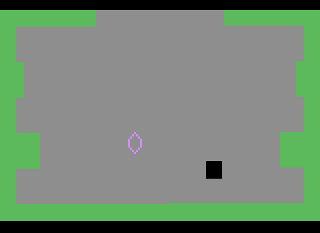 |
| Company: | N/A | |
|
Model #:
|
N/A | |
|
Programmer:
|
Warren Robinett |
|
| Year: | 1983 | |
|
Released?
|
No
|
|
|
Notes:
|
Planned to be a
sequel to Adventure |
A sequel to Adventure? Yes, it appears that we almost got a true sequel to one of the most beloved Atari 2600 games. After leaving The Learning Company, which he founded in 1980 after leaving Atari, Warren Robinett decided to create a new game for the Atari 2600. Deciding to make this new game a direct sequel to the original Adventure isn't surprising since even in 1983 Adventure was still selling well. Warren dubbed this new game Elf Adventure.
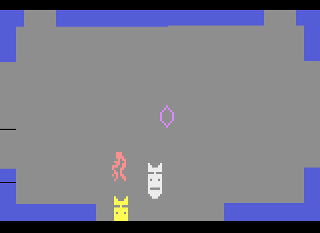
While Elf Adventure is a brand new game, it tries very hard to mimic the style of the original. On the surface it appears that not much has changed, the graphics and sounds appear to be almost the same (your character is even still a square!), but under the hood the game engine has many new features. The kernel has been updated so it could display more than two objects on the screen without blinking (but if more than 2 overlap horizontally they still blink) and some items such as the axe can be now be thrown (although this is a little buggy). However the biggest of update is the 'personality simulation'. According to Warren:
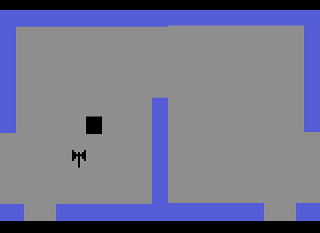
| Jewel |  |
This is one of the seven jewels that
the player would have to retrieve in order to win the
game. |
| Axe |
 |
There are two axes in the game. The first one can be found in the room north of the starting room being carried by the white elf, while the second can be found in the room north of that. |
| Dragon? |  |
Warren believes this may have been the start of a design for an 'angry dragon' which would have breathed fire. |
| Fire? | 
|
Believe it or not, this may be a burst of fire
that was supposed to be breathed out by the dragon. |
Normally the two elves will float serenely across the screen in an endless loop, but if you steal one of the items they hold they will briefly take on a shocked expression then turn angry. Once they turn angry they will pursue the player and attempt to take the item back. However they will always pick up the first item they come across which will give them either a happy or sad expression which is determined by an 'emotion point' system. Warren explains:
"This was my idea in a
nutshell—to have each elf keep its own tally of positive or
negative events with respect to the avatar, and treat the avatar
accordingly. So some elves might be mad at you, others might be
your friends, and yet others might be neutral. You could, for
example, (A) give an elf a gift and then win one point in that
elf's attitude toward you. Or (B), if you stole what the elf was
carrying, you would lose a point. I imagined that there could be
other actions (C, D, E, etc.) on the player's part that might also
win or lose points—but that was for later.
When the elf disliked you, it would start throwing the axe at
you—that was implemented. My idea was that if it liked you, it
would do things to help you—but I don't think I had gotten to that
point. I hadn't even figured out what the action would be. But I
was sure I could come up with something. "
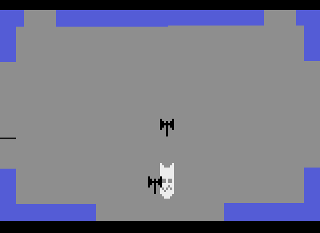
Giving each of the elves their own distinct personalities based on the players actions is pretty groundbreaking for an Atari 2600 game. While this system is somewhat implemented, it's still a little buggy. Each elf has nine different faces based on their current 'emotion point' total plus a surprised and knocked out expression.
"Doodling around on paper, I
found that very simple faces could convey several different
emotions quite effectively, and I could fit these faces into the
8-pixel-wide graphics of the 2600... Nine of the faces
seemed to fit into a 3x3 matrix, and there were a few other
faces that I also thought might be useful."

The items themselves do not appear to do anything yet
with the exception of the axe. So what about those
axes? As it turns out they can actually be used as
weapons! If one of the elves picks up the axe and is in an
angry state it will attempt to throw it at you. If you are
hit an X will appear on your square and you will be stunned for
a few moments, but if the elf misses with his throw the axe will
appear in another room. The same rules apply to the
player, they can attempt to throw the axe at one of the elves by
pressing the fire button while pushing the joystick in the
direction they wish to throw (it may take a few tries to
work). If the axe hits an elf they will take on a
frustrated looking expression and be stunned for a few moments
before resuming their pursuit. This is about all the
gameplay there is in this early prototype. You can kill
the elf multiple times or collect all the items into one room,
but the game does not have a goal yet.
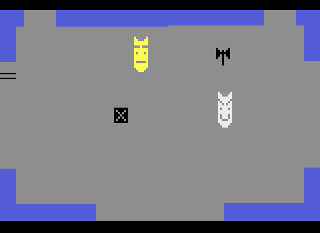
As this is an early prototype there are several bugs in the
code. Throwing the axe is difficult to pull off and
doesn’t always work. If one of the elves hits you with the
axe, they will immediately grab it and try to kill you again
leading to an endless death loop unless you’re quick enough to
get away. The player can get stuck in walls when moving
between rooms which necessitates a reset when encountered.
Lastly the player can pick up and drop the elves themselves
along with any item they’re carrying.
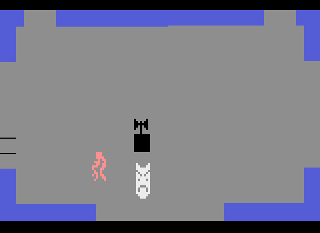
Overall Elf Adventure is a nice enhancement to the original Adventure. The elves really do seem to have personalities which makes the game interesting, but in its current state only the bare basics of the gameplay have been implemented. Unfortunately the game never got any further than the 5/25 prototype and Warren estimates that he only worked on Elf Adventure for about three months before calling it quits.
"I stopped when I realized that Atari and the videogame industry was collapsing. I had a girlfriend who worked at Atari at that time, and she got laid off...so it wasn't that hard to figure out Atari was going down."
If the game if the game had been completed, Warren
describes how it might have looked:
"The plan was... Make some creatures with faces, showing their emotions. Create some ways of pleasing them or pissing them off, thereby changing their emotions. Have their emotions modulate their behaviors. Each elf would have its own emotional state, so different individual elves could be in different states. Set up the game so that it was impossible to win the game without befriending at least some of the elves. If it was easy to befriend them all, it would be too easy (Though that might make a good Level 1.). For the main game, it would be "political"—you would have to figure out which elves to befriend. That's about as far as my thinking went. If this didn't work as well as I hoped, I would make some adjustments."
| Version | Cart Text | Description |
| 4/22/83 | Elf Adv 22 APR 83 |
Very early prototype |
| 5/2/83 | Somewhat playable early version | |
| 5/25/83 | Elf Adv 25 May 83 |
Last known version |
